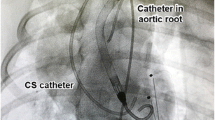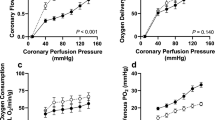Summary
The contractile state of the heart is a major determinant of myocardial oxygen consumption. Since regional myocardial contractility can be severely impaired following a transient coronary occlusion, post-ischemic myocardium is frequently assumed to consume less oxygen. To test this assumption, regional myocardial function and oxygen consumption were studied in ancsthetized dogs during 2 h of myocardial reperfusion following either a 15-min (Group I) or 4-h (Group II) left anterior descending coronary artery occlusion. Both groups developed similar post-ischemic regional dysfunction characterized by paradoxical motion (negative shortening). Measured as a percent of baseline segment shortening, anterior wall function in Group I (n=8) and Group II (n=5) at 30 min of reperfusion was −33±11% and −34±16% (p=NS) and at 120 min was −23±9% and −40±16% (p=NS). However, the two groups showed a marked difference in regional myocardial oxygen consumption during reperfusion. Despite the abnormal wall motion, regional oxygen consumption in Group I at 30 and 120 min of reperfusion was unchanged from pre-ischemic levels as measured as a percent of bascline: 104±20% (p=NS) and 111±21% (p=NS). In contrast, regional oxygen consumption in Group II was markedly depressed from bascline at 30 and 120 min of reperfusion: 42±7% (p<.01) and 40±8% (p<.01). To determine whether the dissociation between regional myocardial oxygen consumption and function in Group I was related to mitochondrial uncoupling, six additional dogs were studied. Tissue samples were obtained from post-ischemic myocardium after 120 min of reperfusion following a 15-min coronary artery occlusion, and compared to non-ischemic myocardium. There were no differences in the in vitro mitochondrial respiratory rates or oxidative phosphorylation capacity between the post-ischemic and non-ischemic myocardium. Therefore, in the post-ischemic myocardium, significant depressions in regional contractility may not be associated with falls in oxygen consumption. Following a 15-min coronary artery occlusion, the injured myocardium maintains a paradoxically high oxygen consumption with normal mitochondrial function despite decreased contractility and abnormal wall motion.
Similar content being viewed by others
References
Braunwald E, Sarnoff SJ, Case RB, Stainsby WN, Welch GH (1958) Hemodynamic determinants of coronary flow: Effect of changes in aortic pressure and cardiac output on the relationship between myocardial oxygen consumption and coronary flow. Am J Physiol 192:157–163
Braunwald E, Kloner RA (1981) The stunned myocardium. Prolonged, post-ischemic ventricular dysfunction. Circulation 66:1146–1149
Ellis SG, Henschke CI, Sandor T, Wynne J, Braunwald E, Kloner RA (1983) Time course of functional and biochemical recovery of myocardium salvaged by reperfusion. J Am Coll Cardiol 1:1047–1055
Fishbein MC, Meerbaum S, Rit J, Lando U, Kanmatsuse K, Mercier JC, Corday E, Ganz W (1981) Early phase acute myocardial infarct size quantification: Validation of the triphenyltetrazolium chloride tissue enzyme staining technique. Am Heart J 101:593–600
Graham TP, Covell JW, Sonnenblick EH, Ross J, Braunwald E (1968) Control of myocardial oxygen consumption: Relative influence of contractile state and tension development. J Clin Invest 47:375–385
Heyndrickx GR, Millard RW, McRitchie RJ, Maroko PR, Vatner SF (1975) Regional myocardial functional and electrophysiological alternations after brief coronary artery occlusion in conscious dogs. J Clin Invest 56:978–985
Heyndrickx GR, Baib H, Nellens P, Leusen I, Fishbein MC, Vatner SF (1978) Depression of regional blood flow and wall thickening after brief coronary occlusions. Am J Physiol 234:H653-H658
Jennings RB, Howkins HK, Lowe JE, Hill ML, Klotman S, Reimer KA (1978) Relation between high energy phosphate end lethal injury in myocardial ischemia in the dog. Am J Path 82:187–207
Kannengicser GJ, Opic LH, Van Der Werff TJ (1979) Impaired cardiac work and oxygen uptake after reperfusion of regionally ischemic myocardium. J Mol Cell Cardiol 11:197–207
Mukherjee AL, Buja M, Kulkarni P, Nicar M, Chien KR, Willerson JT (1982) Relationship of mitochondrial alterations and 99m Tc pyrophosphate uptake during myocardial ischemia. Am J Physiol 243:H268-H276
Murphy ML, Peng CF, Kane JJ, Straub KD (1982) Ventricular performance and biochemical alteration of regional ischemic myocardium after reperfusion in the pig. Am J Cardiol 50:821–828
Reimer KA, Hill ML, Jennings RB (1981) Prolonged depletion of ATP and of the adenine nucleotides following reversible myocardial ischemic injury in dogs. J Mol Cell Cardiol 13:229–239
Roberts DL, Nakazawa HK, Klocke FJ (1976) Origin of great cardiac vein and coronary sinus drainage within the left ventricle. Am J Physiol 230:486–492
Rooke GA, Feigi EO (1982) Work as a correlate of canine left ventricular oxygen consumption, and the problem of catecholamine oxygen wasting. Circ Res 50:273–286
Shlafer M, Kirsh M, Lucchesi BR, Slater AD, Warren S (1981) Mitochondrial function after global cardiac ischemia and reperfusion: Influences of organelle isolation protocols. Basic Res Cardiol 76:250–261
Taylor RR, Cingolani HE, Graham TP, Clancy RL (1967) Myocardial oxygen consumption, left ventricular fibre shortening and wall tension. Cardiovasc Res 1:219–228
Vinten-Johansen JH, Weiss HR (1980) Oxygen consumption in subepicardial and subendocardial regions of the canine left ventricle: The effect of experimental acute valvular aortic stenosis. Circ Res 46:139–152
Wallenstein S, Zucker CL, Fleiss JL (1980) Some statistical methods useful in circulation research. Circ Res 47:1–11
Author information
Authors and Affiliations
Additional information
Grant Support: Dr. Dean was a Fellow of the American Heart Association. Dr. Nicklas is supported by the NIH Clinical Investigator Award, HL 011170.
Rights and permissions
About this article
Cite this article
Dean, E.N., Shlafer, M. & Nicklas, J.M. The oxygen consumption paradox of “stunned myocardium” in dogs. Basic Res Cardiol 85, 120–131 (1990). https://doi.org/10.1007/BF01906965
Received:
Issue Date:
DOI: https://doi.org/10.1007/BF01906965




